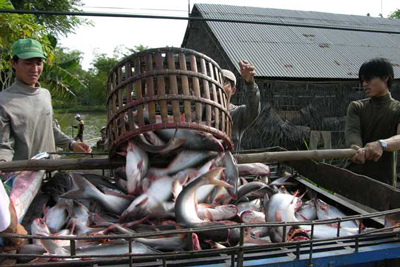The World Wildlife Foundation has added two seafood items of Vietnam onto its consumer ‘red list’, saying their farming production is harmful to the environment.
 |
| Tilapia are raised in many areas in Vietnam |
The two items are shrimp and tilapia, bringing the number of Vietnamese seafood items on the list to three in total as Tra pangasius was added recently, according to the Vietnam Association of Seafood Exporters and Producers (VASEP).
VASEP said tilapia appears in the WWF’s seafood consumer guide in Belgium and shrimp is on the list in Germany. This means that the WWF has warned European buyers not to use these products.
Fishery experts said whether the move that WWF has added tropical seafood products onto its list is aimed to force aquatic breeders and processors to use standards set by the Aquaculture Stewardship Council, an independent and non-profit organisation established by WWF and the Dutch Sustainable Trade Initiative (IDH) in 2009.
In the consumer guides in European markets, WWF mentioned that ASC-labelled tra fish products will be launched in 2011.
Tra fish being added to the list draws strong opposition in Vietnam
Recently, WWF has put Vietnam’s tra pangasius into its seafood consumer guides in European countries, including Germany, Austria, Switzerland, Belgium, Norway and Denmark. The fund explained that tra fish farms pollute the natural environment around them, because nutrients, medicines and pesticides are washed into the surrounding rivers and lakes, which have led to high risk of disease infection to other kinds of fish.
 |
| Tra fish exporters have to meet stringent standards of the US |
In a consumer guide in Germany posted on www.wwf.de, WWF also put Vietnam’s tra pangasius onto a list of items that should not be bought for the reason of being over-fished, facing the risk of extinction and causing bio-diversification imbalance.
Regarding this matter, Nguyen Huu Dung, Deputy Chairman of VASEP, said that it is an unreasonable decision to put tra fish onto this list when the fish are raised in a better environment. The tra catfish products were exported to over 120 countries and territories around the world, and met the stringent standards of the EU, Australia, the US and Japan.
Since 2004, many tra breeding areas in Vietnam have met the standards of the SQF (Safe Quality Food) Institute, a division of the US’s Food Marketing Institute (FMI).
Some tra processing plants and breeding areas in Vietnam have even received Global GAP certificates for good agriculture practice.
Therefore, the information that Vietnamese tra fish appeared in the list has caused anger for not only Vietnamese seafood firms, but also consumers worldwide.
Deputy Minister of Agriculture and Rural Development Vu Van Tam said tra fish is facing unfair campaign which is aimed to smear the fish’s quality on the global market.
VASEP has tried to contact the fund to clarify the issue, but it has not yet received a satisfactory explanation.